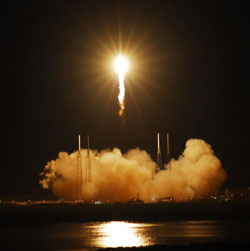The night sky puts on some neat shows this month. And for those of you in the Land Down Under, you can look forward to an eclipse of the sun!
Shortly before dawn on November 26, Venus and Saturn appear very close together:

The evening of November 27 also presents a wonderful show:

Those of you in Australia are in for a real treat this month: An eclipse of the sun! The sun will be totally eclipsed by the moon along a narrow path across the Northern Territory and Queensland. But those of you in the rest of Australia will see a partial eclipse (local weather permitting).

Never look at the sun directly, even during an eclipse! For more information about the eclipse, including how to observe it safely, read “Australia counts down to solar eclipse” appearing in Australia’s Cosmos magazine. Those of you in New Zealand might want to check out the Stardome Observatory’s webpage about the eclipse. Also, no matter where you live, you can watch the eclipse live, online.
Finding your star in the night sky
Stars are located within constellations, which are just areas of the night sky. Scorpius, Aries and Taurus are examples of constellations. Your Name A Star Live Star Certificate displays the name of your constellation. You can use our online World Constellation Guide to determine if you can see your constellation during the evening hours (between sunset and midnight). Of course, you’ll need a telescope to see your star. But you can see your constellation without the use of a telescope. You can also find your constellation by using our Virtual Planetarium™ astronomy software. A planisphere is another useful device.
 “For being the twinkle in my life” — A beautiful Star Certificate message from one of our recent customers!
“For being the twinkle in my life” — A beautiful Star Certificate message from one of our recent customers! When you
When you 











